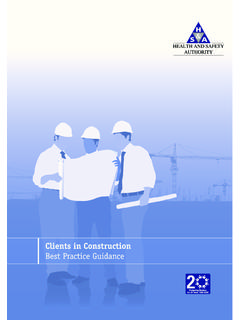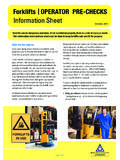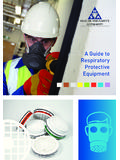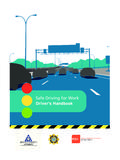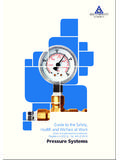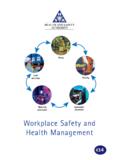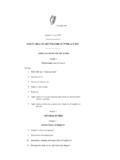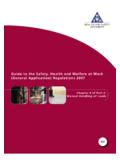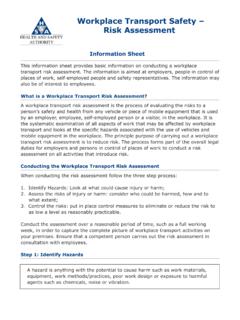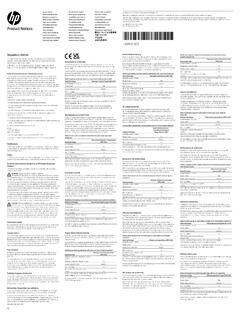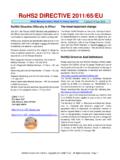Transcription of Guide to the Safety, Health and Welfare at Work (General ...
1 C h a p t e r 2 o f P a r t 2 :U s e o f Wo r k E q u i p m e n tG u i d e t o t h e S a f e t y, H e a l t h a n d We l f a re a t Wo r k2 0 1 0 U p d a t e( G e n e r a l A p p l i c a t i o n ) R e g u l a t i o n s 2 0 0 712 Guide to theSafety, Health and Welfare at Work (General Application) Regulations 2007 Chapter 2 of Part 2:Use of Work EquipmentThis Guidance has been updated in in August 2010 by the Health and Safety Authority, The Metropolitan Building, James Joyce Street, Dublin Guidance has been updated in 2010. All rights reserved. No part of this publication may be reproduced, stored in a retrieval system, or transmitted in any formor by any means, electronic, mechanical, photocopying, recording or otherwise, without the prior permission of the Health andSafety 27: Interpretation for Chapter 2 (as amended)6 Regulation 28: Duties of employer, use of work equipment7 Regulation 29: Information and instruction13 Regulation 30: Inspection of work equipment14 Regulation 31: Maintenance15 Regulation 32: Control devices16 Regulation 33: Guards and protection devices19 Regulation 34: Connection to energy sources22 Regulation 35: Contact with wheels or tracks of Mobile Work Equipment22 Regulation 36: Drive systems of mobile work equipment23 Regulation 37.
2 Combustion engines of mobile work equipment23 Regulation 38: Roll-over of mobile work equipment24 Regulation 39: Fork-lift trucks25 Regulation 40: Safety of Self-Propelled Work Equipment26 Regulation 41: Traffic rules for mobile work equipment28 Regulation 42: Work equipment for lifting loads29 Regulation 43: Cranes33 Regulation 44: Support of lifting equipment36 Regulation 45: Work equipment for lifting goods or persons36 Regulation 46: Hoists and lifts37 Regulation 47: Winch-operated hoists and lifts39 Regulation 48: Conditions regarding lifting of persons39 Use of Work EquipmentRegulation 49: Lifting accessories40 Regulation 50: Work equipment for lifting non-guided loads41 Regulation 51: Lifting equipment signalling and operation43 Regulation 52: Examination and testing of lifting equipment44 Regulation 53: Reports by competent persons46 Regulation 54: Keeping of records and registers of lifting equipment47 Regulation 55: Safe Working loads for excavators, draglines, telehandlers, loaders or combined excavators and loaders when used as cranes48 Regulation 56: Specific requirements for scotch and Guy Derrick Cranes49 Regulation 57: Construction, testing, examination and safe working load of lifting accessories49 Regulation 58: Delivery of loads with lifting accessories attached51 Regulation 59: Duty of persons who hire lifting equipment to others52 Regulation 60.
3 Duty of the master of a ship in respect of examination of lifting equipment52 Regulation 61: Duty of the owner of a fishing vessel in respect of examination of lifting equipment52 Schedule 1: Requirements for Work Equipment53 Appendix: Sources of Further Information and Bibliography57 Guide to Chapter 2 of Part 2 of the General ApplicationRegulations 2007 Chapter 2 of Part 2: USE OF WORK EQUIPMENTI ntroductionThis Guide is aimed at safety and Health practitioners, employers, managers,employees, safety representatives and others to give guidance on Chapter 2 of Part2 and the related Schedule 1 to the Safety, Health and Welfare at Work (GeneralApplication) Regulations 2007 ( No. 299 of 2007) as amended by the Safety, Health and Welfare at Work (General Application) (Amendment) Regulations 2007( No.)
4 732 of 2007) relating to the use of work equipment. The objective of theguide is to give general guidance aimed at the prevention of occupational accidentsor ill is not intended as a legal interpretation of the isit a detailed technical document that covers all the implications of any givenRegulation. What may be covered in a few lines in a Regulation may be the subjectof a lengthy technical standard or code of practice. From 1 November 2007, Chapter 2 of Part 2 of the Safety, Health and Welfare atWork (General Application) Regulations 2007 as amended, replaces the workequipment provisions of the Safety, Health and Welfare at Work (GeneralApplication) Regulations 1993 ( No. 44 of 1993) as amended by the Safety, Health and Welfare at Work (General Application) (Amendment) Regulations 2001( of 2001), which are revoked from that date.
5 In this Guide the text of the Regulations is shown in General Application Regulations 2007 are made under the Safety, Health andWelfare at Work Act 2005 (No. 10 of 2005) referred to elsewhere in this Guide as the Act or the 2005 Act .The Regulations retranspose Council directive 89/655/EEC, as amended byCouncil directive 95/63/EEC on the use of work equipment. The generalrequirements apply to work equipment in any location. They also consolidate therequirements for lifting equipment for all work sectors except offshore and miningwhere the existing Regulations remain definition of work equipment, any machinery, appliance, apparatus, toolor installation for use at work in Regulation 2 is all inclusive. It ranges fromcomplex machinery such as a printing machine to hand tools such as a provisions of the Regulations and Schedule 1 are only applicable to the extentthat they are relevant to the work equipment in are some topics which are relevant not only to work equipment but also fallunder a number of other Parts of the Regulations such as electricity (Part 3), workat height (Part 4), noise and vibration (Part 5) and explosive atmospheres (Part 8).
6 Use of Work EquipmentRegulations 2007 5 These Regulations apply to equipment in use; they do not cover the duties of those placing equipmenton the market for the first time, including issues of ce marking and declarations of of the Regulations overlap in scope, reflecting their different 2 of Part 2 of the General Application Regulations 2007 covers Regulations 27 to , in addition to the definition of work equipment, Regulation 2 also defines liftingequipment as work equipment for lifting, lowering loads or pile driving and includes anything usedfor anchoring, fixing or supporting such equipment .The scope of potential workplaces covered by Chapter 2 of Part 2 is much broader than that addressedin Chapter 1 of Part 2 relating to the 27: Interpretation for Chapter 2 as amended by the Safety, Health and Welfare at Work (General Application)(Amendment) Regulations 2007 ( No.)
7 732 of 2007) this Chapter: carrier means the device by which persons or goods, or both, are supported in order to belifted, lowered or moved; danger zone means any zone within or around work equipment in which an employee issubject to a risk to his or her safety or Health ; EC declaration of conformity refers to a declaration of conformity issued pursuant toDirective 98/37/EC or directive 2006/42/EC of the European Parliament and of the Council onthe approximation of the laws of the Member States relating to machinery; exposed employee means any employee wholly or partially in a danger zone; fishing vessel means a vessel to which the Safety, Health and Welfare at Work (FishingVessels) Regulations 1999 ( No. 325 of 1999) apply; hoist or lift means a lifting machine which has its direction of movement restricted by aguide or guides but, for the purpose of this Chapter, does not include (a) a fork lift truck, order picker, self-propelled variable reach truck or similar type equipment,(b) platform lifts for use by persons with impaired mobility,(c) lifting equipment intended for lifting performers during artistic performances, or(d) lifting equipment fitted in means of transport.
8 (as amended by the Safety, Health and Welfare at Work (General Application) (Amendment) Regulations 2007) Guide to the Safety, Health and Welfare at Work (General Application)6 lifting accessories include clamps and similar attachments, chain slings,rope slings, rings, hooks, shackles, swivels, spreader beams, spreaderframes and any other item placed between lifting equipment and the load oron the load in order to attach it, but excluding features of the load used forits lifting; load includes a person; non-integrated cage or basket means one which is not equipped withcontrols that control its movement; selection, installation and use of work equipment means any activityinvolving work equipment, including starting or stopping the equipment, itsuse, transport, repair, modification, maintenance and servicing andcleaning; thorough examination includes testing if (a) a competent person considers it to be necessary for the purpose of the examination, or(b) testing is required pursuant to Regulation 52 and Schedule of the implications of the definitions will be explored in the sections of thisGuide dealing with particular Regulations.
9 Regulation 28: Duties of employer, use of work employer shall ensure that (a) any work equipment provided for use by employees at a place of work complies, as appropriate, with the provisions of any relevant enactment implementing any relevant directive of the European Communities relating to work equipment with respect to safety and Health ,There are EU Directives that deal with the placing on the EU market, for the firsttime, of goods such as machinery, lifts, simple pressure vessels and pressureequipment, personal protective equipment and electrical equipment. TheseDirectives also deal with the importing into the EU of second-hand equipmentwhere the importer becomes responsible for compliance with the Directives. TheDirectives cover essential Health and safety requirements, ce marking , declarationsof conformity and the need for third-party conformity assessment.
10 Regulation 28(a) requires employers to ensure that any new equipment, or anysecond-hand equipment imported from outside the EU, which they are providingcomplies with the requirements of these Directives. Useful information can befound on the EU websites dedicated to the particular of Work EquipmentRegulations 2007 7 The Regulation does not require employers to change their existing equipment to meet the samestandards as new equipment, although these standards can be a source of guidance for dealing withparticular problems.(b) in selecting the work equipment, account is taken of the specific working conditions, characteristics and hazards in the place of work having regard to the safety and Health of the employees and any additional hazards posed by the use of such work equipment,(c) the necessary measures are taken so that the work equipment is installed and located and is suitable for the work to be carried out, or is properly adapted for that purpose, and may be used by employees without risk to their safety and Health ,There are many situations, involving, for instance, wet, flammable, explosive, noisy, dusty or dirtyatmospheres, where special care is needed in selecting and installing work equipment so as not to placeemployees at risk.
